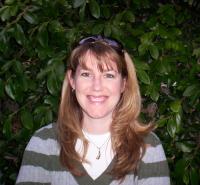 Yesterday we arrived! I took my first steps on board the R/V Atlantis. That’s a view of its stern to the right. It’s quite an awesome ship for a research vessel. The first thing that struck me when I stepped on board (besides the fact that I had packed too much in my duffel bag) was all the smiling faces of the crew members. I was excited to see the cabin I would call home for the next two weeks. It’s quite nice for a ship cabin with a comfy chair, lockers, shelves, even our own personal sink. I share my cabin with a graduate student, also named Jill, and I feel lucky that I got the top bunk! I admit that I got lost a couple times at first trying to find my cabin, but I think I’ve got it down now.
Yesterday we arrived! I took my first steps on board the R/V Atlantis. That’s a view of its stern to the right. It’s quite an awesome ship for a research vessel. The first thing that struck me when I stepped on board (besides the fact that I had packed too much in my duffel bag) was all the smiling faces of the crew members. I was excited to see the cabin I would call home for the next two weeks. It’s quite nice for a ship cabin with a comfy chair, lockers, shelves, even our own personal sink. I share my cabin with a graduate student, also named Jill, and I feel lucky that I got the top bunk! I admit that I got lost a couple times at first trying to find my cabin, but I think I’ve got it down now.
All of the scientists are busy setting up their lab spaces, from scratch! It’s such a big job. There are two different chemistry labs here, one for fluid chemistry and one for dissolved gasses. There’s also a lab set up for the microbiologist, and one for our paleontologist will share their space. Even the FLEXE education team, which I am part of, set up a workspace too.
Perhaps the best thing about yesterday, however, was meeting my hero for the first time. From the time I was an undergraduate marine biology student I had heard of him. He has been all around the world, has worked with some of the world’s best scientists, and was there when some of the greatest deep-sea discoveries were made. In fact, he helped to collect the temperature data sets that you FLEXE students have been studying. He’s been around for quite a while now and has undergone a few “face lifts” so he is performing better than ever. I do appreciate his age, however, because I think “salty old dogs” make the best sailing companions. I stepped through one of the ships water-tight doors and there he was. Alvin is awesome– perhaps a bit smaller than I expected (you know, because I had such a big image of him in my head), but very regal and proud looking. I reached out my hand and touched him with my finger and chills ran down my spine. He is magnificent…
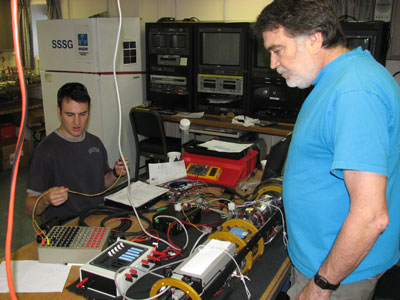 We set sail today at 1100 hours. Most people on the Atlantis are veterans of sailing on this ship, but for me, and a few other scientists, it’s all brand new. The picture to the left shows the Alvin Pilot, Sean Kelley and University of Washington oceanographer, Dr. Marv Lilley, working on the mass spectrophotometer.
We set sail today at 1100 hours. Most people on the Atlantis are veterans of sailing on this ship, but for me, and a few other scientists, it’s all brand new. The picture to the left shows the Alvin Pilot, Sean Kelley and University of Washington oceanographer, Dr. Marv Lilley, working on the mass spectrophotometer.
There are so many new names to learn, rules to learn, and even information about the subject of the scientific research to learn. It seems a lot like the first day of school to me, only this time I’m the student, not the teacher.
There was a sense of urgency today, or perhaps it was necessity, to make sure everyone knew what to do in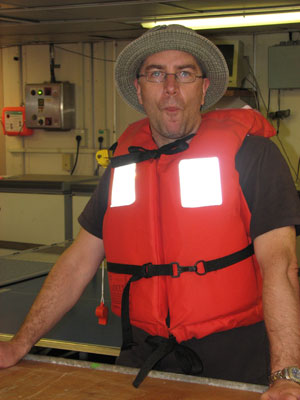 order to be safe on the ship. We had several meetings that started right away in the morning focusing on safety. We learned about our requirements to wear proper shoes (even though it’s hot out, no flip flops allowed!), rope hazards, fire safety, and of course what to do in the event we need to abandon ship. Everyone had to wear their very trendy orange life vests and find their assigned emergency raft. I have to say, we all behaved much better than most students do through fire drills at school! It’s all very serious, but we also tell little jokes along the way. I learned from University of Leeds paleontologist, Dr. Cris Little (on the right at the safety drill in his life preserver) that enjoying a piece of ginger candy can be useful for potential sea sickness. Über cool hat!
order to be safe on the ship. We had several meetings that started right away in the morning focusing on safety. We learned about our requirements to wear proper shoes (even though it’s hot out, no flip flops allowed!), rope hazards, fire safety, and of course what to do in the event we need to abandon ship. Everyone had to wear their very trendy orange life vests and find their assigned emergency raft. I have to say, we all behaved much better than most students do through fire drills at school! It’s all very serious, but we also tell little jokes along the way. I learned from University of Leeds paleontologist, Dr. Cris Little (on the right at the safety drill in his life preserver) that enjoying a piece of ginger candy can be useful for potential sea sickness. Über cool hat!
We even had some Alvin (submersible) training today, where much of the focus was also safety. It was fascinating to learn about all that goes into simply maintaining the “air” inside the submersible. Perhaps I will share more on that later.
 It is quite an experience living on a ship and I am finding it quite enjoyable. The people come from all walks of life from all around the world. It can be a very hazardous environment, and yet I have never felt safer. Tonight as I write this I have the pleasure of sitting on the deck, under the stars, next to some wonderful people I have met including Ronnie Whims, a member of the crew who is also quite an accomplished guitar player. His music helps me remember these past two days. I know that this cruise will be quite an experience.
It is quite an experience living on a ship and I am finding it quite enjoyable. The people come from all walks of life from all around the world. It can be a very hazardous environment, and yet I have never felt safer. Tonight as I write this I have the pleasure of sitting on the deck, under the stars, next to some wonderful people I have met including Ronnie Whims, a member of the crew who is also quite an accomplished guitar player. His music helps me remember these past two days. I know that this cruise will be quite an experience.
So I will leave you all this evening with a question for you to ponder and perhaps respond to… How do you think you might feel getting acquainted to a new school or to new experiences like going on a scientific research expedition?
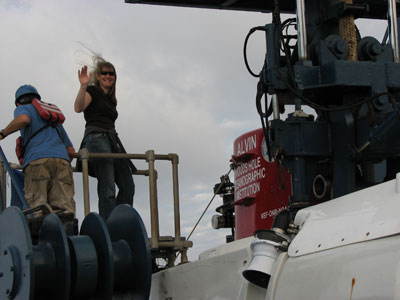 The minute I stepped back on deck, everyone asked me, “So, how was it?”I have found answering this question to be a bit challenging as I am still somewhat overwhelmed by the adventure that began when I boarded Alvin. How does one describe something so beautiful? How can I possibly articulate what a mind-blowing experience it was? Perhaps the biggest impressions I am left with are the beauty of the environment and the joy of working with wonderful people.
The minute I stepped back on deck, everyone asked me, “So, how was it?”I have found answering this question to be a bit challenging as I am still somewhat overwhelmed by the adventure that began when I boarded Alvin. How does one describe something so beautiful? How can I possibly articulate what a mind-blowing experience it was? Perhaps the biggest impressions I am left with are the beauty of the environment and the joy of working with wonderful people. 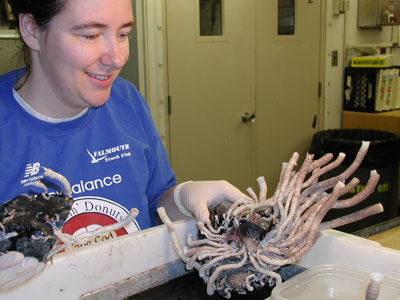 Although I am now a science teacher, I did have an opportunity to be exposed to science research while getting my marine biology degree, and while working as a biologist. The one thing I appreciate the most about being involved in scientific research is how inter-connected everything is. For example, Biologist Kate Buckman’s work on Tevnia tubesorms that attach themselves to the cracks of a piece of basalt rock (shown in image to left) can cross over into the work of a scientist
Although I am now a science teacher, I did have an opportunity to be exposed to science research while getting my marine biology degree, and while working as a biologist. The one thing I appreciate the most about being involved in scientific research is how inter-connected everything is. For example, Biologist Kate Buckman’s work on Tevnia tubesorms that attach themselves to the cracks of a piece of basalt rock (shown in image to left) can cross over into the work of a scientist 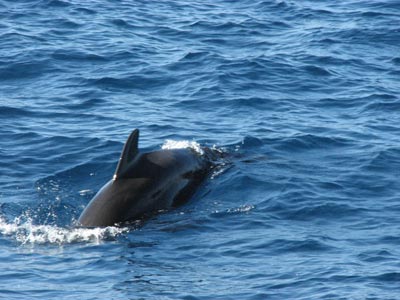 19Dec2007
19Dec2007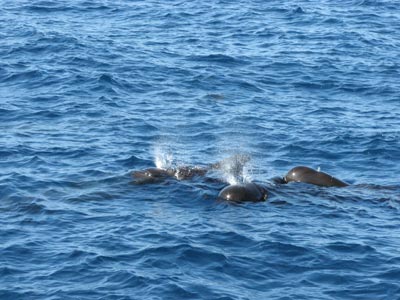 Sure enough, I looked out and saw several small whales off in the distance. They were swimming near the surface, coming up for the occasional breath. In a matter of a few moments, they approached the ship and I was able to get a great view. At first it seemed like there were only about four or five whales, but I gradually began to realize that there were around 20-30 whales!
Sure enough, I looked out and saw several small whales off in the distance. They were swimming near the surface, coming up for the occasional breath. In a matter of a few moments, they approached the ship and I was able to get a great view. At first it seemed like there were only about four or five whales, but I gradually began to realize that there were around 20-30 whales!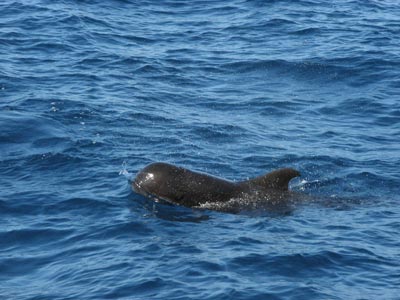
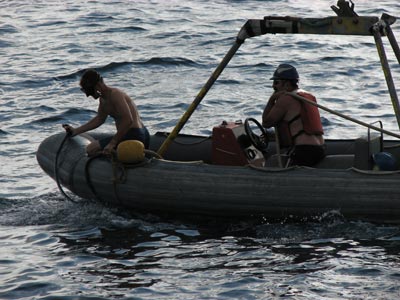 A loud horn sounds and breaks the melodic murmur of the ship’s engines. There’s a special buzz on the ship and everyone is now distracted from their current task. Wayne, the ship’s Boson, signals the crane operator to lower the avon into the water. Carrying the two swimmers, Jerry Graham, one of the ship’s Able-Bodied Seamen, steers the Avon toward Alvin, which has surfaced from the depths of the ocean. The process of bringing Alvin back on deck will take around 30-45 minutes. All the while, the scientists linger in anticipation of the day’s
A loud horn sounds and breaks the melodic murmur of the ship’s engines. There’s a special buzz on the ship and everyone is now distracted from their current task. Wayne, the ship’s Boson, signals the crane operator to lower the avon into the water. Carrying the two swimmers, Jerry Graham, one of the ship’s Able-Bodied Seamen, steers the Avon toward Alvin, which has surfaced from the depths of the ocean. The process of bringing Alvin back on deck will take around 30-45 minutes. All the while, the scientists linger in anticipation of the day’s  Today I had the opportunity to visit the crew that was working on the bridge of the ship. I ran into Jim McGill, the ship’s Able-Bodied Seaman (in the picture to the right), who was on duty at the time. We noticed, off in the distance, a dark sky. The clouds ahead of us were the darkest I had seen in my short time on the ship. “A squall is headed this way”, said Jim, “it’ll be here in 10 minutes”. It was amazing to see the sky continue to darken, and to actually watch the storm system approach the ship. Within a couple of minutes, the ship was surrounded by clouds (there was almost no visibility), rain was pouring down, and the wind-speed went from a breezy 10 to a strong 34 knots.
Today I had the opportunity to visit the crew that was working on the bridge of the ship. I ran into Jim McGill, the ship’s Able-Bodied Seaman (in the picture to the right), who was on duty at the time. We noticed, off in the distance, a dark sky. The clouds ahead of us were the darkest I had seen in my short time on the ship. “A squall is headed this way”, said Jim, “it’ll be here in 10 minutes”. It was amazing to see the sky continue to darken, and to actually watch the storm system approach the ship. Within a couple of minutes, the ship was surrounded by clouds (there was almost no visibility), rain was pouring down, and the wind-speed went from a breezy 10 to a strong 34 knots. All of this peaked my curiosity and I began to ask Jim more questions about weather. Apparently, 9ºN (our study site on this research cruise) is in the middle of an oceanic phenomenon known as the Inter-Tropical Convergence Zone, an area where cool northern currents collide with warmer southern currents. The result is rather “swelly” water and the occasional storm system.
All of this peaked my curiosity and I began to ask Jim more questions about weather. Apparently, 9ºN (our study site on this research cruise) is in the middle of an oceanic phenomenon known as the Inter-Tropical Convergence Zone, an area where cool northern currents collide with warmer southern currents. The result is rather “swelly” water and the occasional storm system.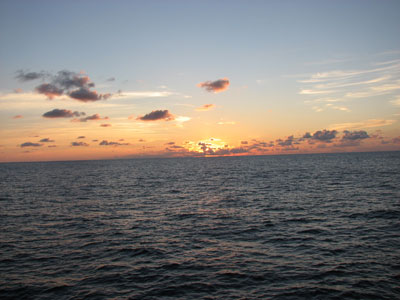 December 11, 2007
December 11, 2007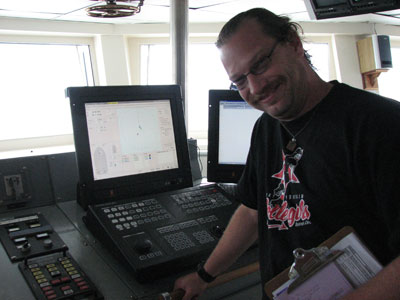 When the Chief Scientist planned this research expedition, she gave the Captain of the Ship the coordinates for the location she wanted to go. So in my head popped a big question: how does the ship find the location? I had a chance today to speak with PJ Leonard, the Ship’s Chief Mate (in the picture on the right) who was kind enough to show me one of the most interesting parts of the ship, the Bridge. It really is the nerve center of the ship as this is where they control the ship. Located on the Bridge is the ships elegant system of navigation through the use of GPS (Global Positioning System). But this isn’t quite the same as your automobile’s GPS - its more complex.
When the Chief Scientist planned this research expedition, she gave the Captain of the Ship the coordinates for the location she wanted to go. So in my head popped a big question: how does the ship find the location? I had a chance today to speak with PJ Leonard, the Ship’s Chief Mate (in the picture on the right) who was kind enough to show me one of the most interesting parts of the ship, the Bridge. It really is the nerve center of the ship as this is where they control the ship. Located on the Bridge is the ships elegant system of navigation through the use of GPS (Global Positioning System). But this isn’t quite the same as your automobile’s GPS - its more complex.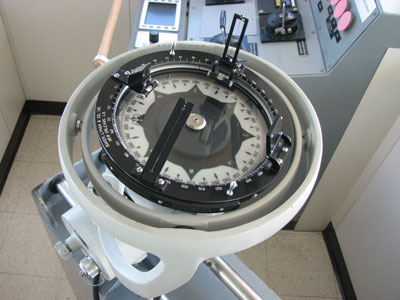 To assist the GPS, the ship has three gyros that are like fancy compasses (see image on the left). Two of these gyros measure the Earth’s rotation, and one acts as an accelerometer to provide information on altitude and motion on an axis. The ship also uses radar technology to determine its distance from other objects (right now, the only other objects showing up on radar are clouds!) Finally, there is one other piece of sophisticated technology that the bridge uses. It’s so important that PJ wanted to make sure I told you about it. It’s satellite radio, so the bridge can have music accompany them during their shifts. Sadly though, we are now too far south to pick up on the signal. Perhaps I’ll loan him my iPod for a while!
To assist the GPS, the ship has three gyros that are like fancy compasses (see image on the left). Two of these gyros measure the Earth’s rotation, and one acts as an accelerometer to provide information on altitude and motion on an axis. The ship also uses radar technology to determine its distance from other objects (right now, the only other objects showing up on radar are clouds!) Finally, there is one other piece of sophisticated technology that the bridge uses. It’s so important that PJ wanted to make sure I told you about it. It’s satellite radio, so the bridge can have music accompany them during their shifts. Sadly though, we are now too far south to pick up on the signal. Perhaps I’ll loan him my iPod for a while! Yesterday we arrived! I took my first steps on board the R/V Atlantis. That’s a view of its stern to the right. It’s quite an awesome ship for a research vessel. The first thing that struck me when I stepped on board (besides the fact that I had packed too much in my duffel bag) was all the smiling faces of the crew members. I was excited to see the cabin I would call home for the next two weeks. It’s quite nice for a ship cabin with a comfy chair, lockers, shelves, even our own personal sink. I share my cabin with a graduate student, also named Jill, and I feel lucky that I got the top bunk! I admit that I got lost a couple times at first trying to find my cabin, but I think I’ve got it down now.
Yesterday we arrived! I took my first steps on board the R/V Atlantis. That’s a view of its stern to the right. It’s quite an awesome ship for a research vessel. The first thing that struck me when I stepped on board (besides the fact that I had packed too much in my duffel bag) was all the smiling faces of the crew members. I was excited to see the cabin I would call home for the next two weeks. It’s quite nice for a ship cabin with a comfy chair, lockers, shelves, even our own personal sink. I share my cabin with a graduate student, also named Jill, and I feel lucky that I got the top bunk! I admit that I got lost a couple times at first trying to find my cabin, but I think I’ve got it down now. We set sail today at 1100 hours. Most people on the Atlantis are veterans of sailing on this ship, but for me, and a few other scientists, it’s all brand new. The picture to the left shows the Alvin Pilot, Sean Kelley and University of Washington oceanographer, Dr. Marv Lilley, working on the mass spectrophotometer.
We set sail today at 1100 hours. Most people on the Atlantis are veterans of sailing on this ship, but for me, and a few other scientists, it’s all brand new. The picture to the left shows the Alvin Pilot, Sean Kelley and University of Washington oceanographer, Dr. Marv Lilley, working on the mass spectrophotometer. order to be safe on the ship. We had several meetings that started right away in the morning focusing on safety. We learned about our requirements to wear proper shoes (even though it’s hot out, no flip flops allowed!), rope hazards, fire safety, and of course what to do in the event we need to abandon ship. Everyone had to wear their very trendy orange life vests and find their assigned emergency raft. I have to say, we all behaved much better than most students do through fire drills at school! It’s all very serious, but we also tell little jokes along the way. I learned from University of Leeds paleontologist, Dr. Cris Little (on the right at the safety drill in his life preserver) that enjoying a piece of ginger candy can be useful for potential sea sickness. Über cool hat!
order to be safe on the ship. We had several meetings that started right away in the morning focusing on safety. We learned about our requirements to wear proper shoes (even though it’s hot out, no flip flops allowed!), rope hazards, fire safety, and of course what to do in the event we need to abandon ship. Everyone had to wear their very trendy orange life vests and find their assigned emergency raft. I have to say, we all behaved much better than most students do through fire drills at school! It’s all very serious, but we also tell little jokes along the way. I learned from University of Leeds paleontologist, Dr. Cris Little (on the right at the safety drill in his life preserver) that enjoying a piece of ginger candy can be useful for potential sea sickness. Über cool hat! It is quite an experience living on a ship and I am finding it quite enjoyable. The people come from all walks of life from all around the world. It can be a very hazardous environment, and yet I have never felt safer. Tonight as I write this I have the pleasure of sitting on the deck, under the stars, next to some wonderful people I have met including Ronnie Whims, a member of the crew who is also quite an accomplished guitar player. His music helps me remember these past two days. I know that this cruise will be quite an experience.
It is quite an experience living on a ship and I am finding it quite enjoyable. The people come from all walks of life from all around the world. It can be a very hazardous environment, and yet I have never felt safer. Tonight as I write this I have the pleasure of sitting on the deck, under the stars, next to some wonderful people I have met including Ronnie Whims, a member of the crew who is also quite an accomplished guitar player. His music helps me remember these past two days. I know that this cruise will be quite an experience.